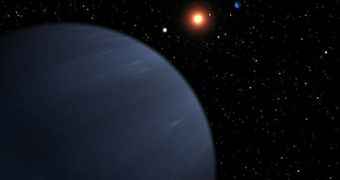Astronomers have believed for a long time that only the more massive stars, from about the same mass of our Sun upwards, could host an exoplanet system. The main considerate for this was size, as the researchers inferred that only a star with a large mass could give birth to planets around it. However, a recent find, made via a process called astrometry, shows that Jupiter-sized planets can exist even around the smallest and least intense stars in the Universe, a discovery that really puzzles astronomers.
“This is an exciting discovery because it shows that planets can be found around extremely lightweight stars. This is a hint that nature likes to form planets, even around stars very different from the sun,” the NASA Exoplanet Exploration Program Chief Scientist Wesley Traub, from the agency's Jet Propulsion Laboratory (JPL), in Pasadena, California, said of the new find.
“This method [astrometry] is optimal for finding solar-system configurations like ours that might harbor other Earths. We found a Jupiter-like planet at around the same relative place as our Jupiter, only around a much smaller star. It's possible this star also has inner rocky planets. And since more than seven out of 10 stars are small like this one, this could mean planets are more common than we thought,” JPL team member Steven Pravdo added, quoted by Space.
The measuring technique was first proposed more than half a century ago, but wielding it has proven to be extremely demanding, even for the best prepared professionals. Basically, in this method, telescopes analyze and measure a certain star, and wait until they see minute variations in its luminosity. When this happens, experts know that it could mean an exoplanet moved between the telescope and the star. However, it takes a long time to use this method, and it often fails. As proof, this is the first exoplanet found using it, but astrophysicists say it was worth the wait.
The planetary system is located just 20 light-years away, in the Constellation Aquila. Exoplanet VB 10b has been labeled as a “cold Jupiter,” which means that it orbits its parent star (VB 10) at about the same distance Jupiter orbits the Sun. However, astronomers have determined that the exoplanet is, in fact, six times the size of Jupiter and that, most likely, the temperatures on it are fairly high, on account of the fact that the gas giant creates heat of its own.
“Other known exoplanets around larger M-dwarf stars are also similar to our Jupiter, making the stars fertile ground for future Earth searches. Astrometry is best suited to find cold Jupiters around all kinds of stars, and thus to find more planetary systems arranged like our home,” Stuart Shaklan, who is also a JPL team member, concluded.

 14 DAY TRIAL //
14 DAY TRIAL //